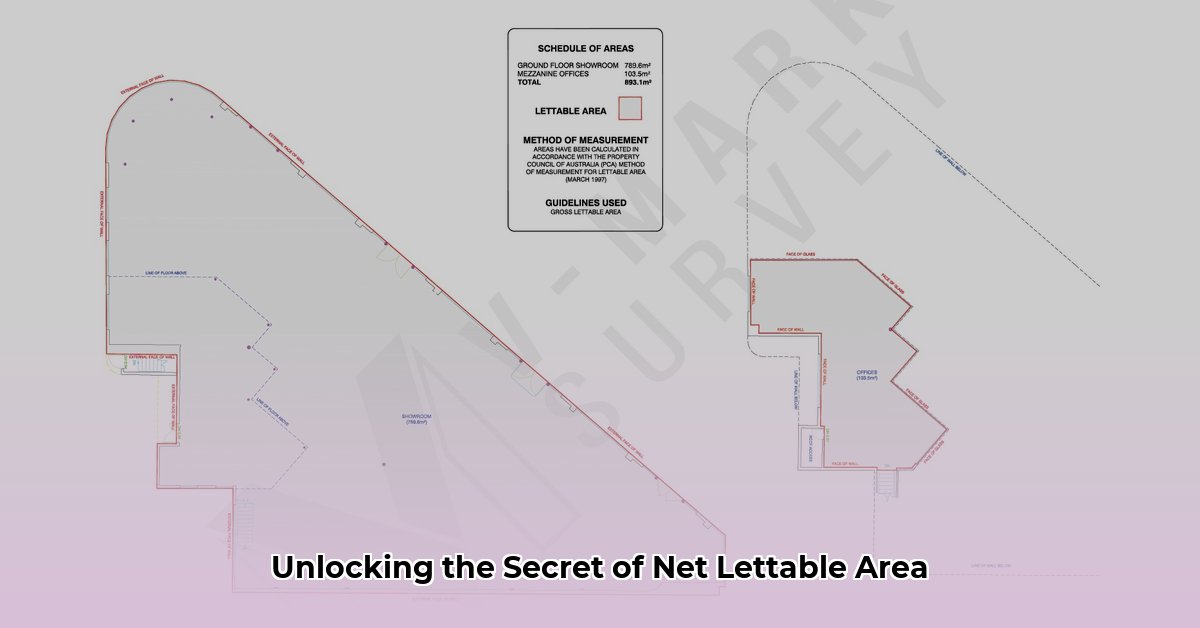What is NLA?
Renting commercial space? Understanding Net Lettable Area (NLA) is crucial. It’s the usable square footage you pay for, excluding shared areas like lobbies and restrooms. This guide breaks down NLA, its calculation, importance in lease negotiations, and impact on your bottom line.
Calculating NLA
Figuring out NLA is straightforward. Here’s a simplified guide:
- Measure the Total Floor Area: Measure wall-to-wall, including everything.
- Subtract Common Areas: Deduct the square footage of shared spaces (lobbies, hallways, restrooms, stairwells, elevator shafts, building service areas).
- Subtract Exterior Wall Thickness: Exclude the thickness of exterior walls.
- The Result Is the NLA: The remaining space is the usable area you lease and pay for.
Think of a pizza: the entire pizza is the gross floor area; the crust is like the common areas and wall thickness; the NLA is the edible part.
NLA vs. GLA
NLA is often confused with Gross Leasable Area (GLA). GLA is the total area within the building, including common areas. NLA is only the usable portion a tenant exclusively occupies. This distinction is vital during lease negotiations.
Why NLA Matters in Lease Negotiations
NLA is the cornerstone of commercial lease negotiations. It directly impacts your rent. A larger NLA generally means higher rent. Savvy tenants use this knowledge to negotiate effectively. Always verify NLA calculations independently for a fair deal.
Here’s a table summarizing NLA inclusions and exclusions:
| Included in NLA | Excluded from NLA |
|---|---|
| Private offices | Building lobby |
| Dedicated workspaces | Hallways |
| Storage rooms within your space | Restrooms |
| Private balconies (sometimes) | Stairwells and Elevators |
| In-suite server rooms | Building Mechanical/Service Areas |
| Exterior Wall Thickness |
Regional and Legal Considerations
NLA calculations may vary regionally. While the Property Council of Australia (PCA) offers a widely accepted method, variations exist. Consulting local real estate experts and legal professionals is advisable. Review your lease agreement diligently. It should clearly define the NLA and its calculation method.
Resolving NLA Disputes
Disagreements over NLA can occur. Thorough documentation, accurate measurements, and clear lease terms can prevent these. If discrepancies arise, open communication with your landlord and reviewing agreed-upon measurement standards are crucial. Consider an independent expert for unbiased assessment if needed.
Maximizing NLA for Your Business
Understanding NLA helps optimize your space and budget. Accurate calculation and negotiation ensure you pay a fair price for occupied space. This knowledge significantly impacts your bottom line.
Deeper Dive into NLA Calculations
Calculating NLA involves detailed steps:
- Measure the Total Floor Area (TFA): Measure the entire floor, every nook and cranny.
- Identify and Measure Common Areas (CA): Measure shared spaces (lobbies, hallways, restrooms, etc.).
- Measure Structural Elements (SE): Measure structural components (columns, load-bearing walls).
- Measure Non-Leasable Spaces (NLS): Measure areas like mechanical rooms and electrical closets.
- Calculate NLA: Subtract CA, SE, and NLS from TFA. This is your rentable space.
Example: A 5,000 sq ft building with 750 sq ft of CA, 250 sq ft of SE, and 500 sq ft of NLS has an NLA of 3,500 sq ft.
| Element | Area (sq ft) |
|---|---|
| Total Floor Area (TFA) | 5,000 |
| Common Areas (CA) | 750 |
| Structural Elements (SE) | 250 |
| Non-Leasable Spaces (NLS) | 500 |
| Net Lettable Area (NLA) | 3,500 |
NLA and Property Value
NLA significantly impacts property value. A higher NLA suggests greater income potential, increasing market value. Investors prioritize properties with maximized rentable space for better ROI.
NLA vs. GLA: Detailed Comparison
NLA and GLA are distinct:
| Feature | Gross Leasable Area (GLA) | Net Leasable Area (NLA) |
|---|---|---|
| Definition | Total tenant space + allocated portion of shared areas | Usable space within tenant’s premises, excluding common areas |
| Common Areas | Included (proportionally) | Excluded |
| Typical Use | Retail leases | Office leases |
| Impact on Rent | Influences total rent | Determines rentable space, impacting rent per sq ft |
| Example | Store in a mall, including allocated walkway | Office suite, excluding shared lobby |
Calculating NLA: A Refined Approach
Calculating NLA involves:
- Measure the Interior: Measure the length and width of your space.
- Subtract Internal Exclusions: Subtract areas within your space you don’t exclusively use (e.g., private restrooms).
- Consider Pro-Rata Share of Common Areas: Your lease may allocate a portion of common areas based on your building footprint.
- Consult Your Lease: The lease agreement is the definitive guide for NLA calculation.
NLA in Your Lease: Key Points
- Clear Definition: Ensure a clear NLA definition in your lease.
- Core Factor/Load Factor: Understand this percentage added to NLA to arrive at GLA. Negotiate if necessary.
- Ask Questions: Seek clarification from your landlord or a real estate professional.
Ongoing Research and Evolving Standards
Research on NLA measurement and its implications is ongoing. While BOMA provides guidelines, the industry continually refines practices. The rise of flexible workspaces may necessitate further evolution in NLA calculations. Staying informed about these changes is crucial. Some experts suggest that future NLA calculations might incorporate factors like access to amenities and technological infrastructure, reflecting the changing needs of modern businesses. Others believe that blockchain technology could enhance transparency and efficiency in NLA measurement and verification, potentially reducing disputes. These are areas of ongoing research and discussion within the real estate industry.
By understanding NLA, you can confidently navigate commercial leasing and optimize your workspace and expenses. Remember that consulting local real estate experts and legal professionals provides tailored advice for your specific situation. This guide serves as a starting point for understanding the nuances of NLA, empowering you in commercial real estate dealings.
- How To Make Electricity At Home With Water Using DIY Micro-Hydro - December 7, 2025
- How to Generate Electricity from Water at Home for Off-Grid Power - December 6, 2025
- Small Scale Hydropower Brings Sustainable Energy to Rural Areas - December 5, 2025
















